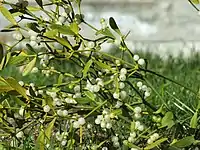mistletoe
See also: mistle-toe
English
WOTD – 24 December 2018
Etymology

A European mistletoe (Viscum album; sense 1) plant
.jpg.webp)
A Victorian trade card depicting mistletoe hung up as a Christmas decoration (sense 2), with two people kissing beneath it
From Middle English mistelto, mistilto (“European mistletoe”), from Old English misteltān, mistiltān (“mistletoe”), from mistel (“mistletoe; basil; birdlime”) + tān (“sprig, shoot, twig”), possibly as a calque of Old Norse mistilteinn; equivalent to mistle + tan (“twig”). This was mistaken for the plural of tā (“toe”)).[1] Cognate with Danish mistelten (“mistletoe”), Norwegian misteltein (“mistletoe”), Icelandic mistilteinn (“mistletoe”). Compare also the simplex form West Frisian mistel (“mistletoe”), Dutch mistel (“mistletoe”), German Mistel (“mistletoe”), Swedish mistel (“mistletoe”).
Pronunciation
- (Received Pronunciation) IPA(key): /ˈmɪs(ə)ltəʊ/
- (General American) IPA(key): /ˈmɪsəlˌtoʊ/
Audio (AU) (file) - Hyphenation: mis‧tle‧toe
Noun
mistletoe (countable and uncountable, plural mistletoes)
- (countable, uncountable) Any of numerous hemiparasitic evergreen plants of the order Santalales with white berries that grow in the crowns of apple trees, oaks, and other trees, such as the European mistletoe (Viscum album) and American mistletoe or eastern mistletoe (Phoradendron leucarpum).
- 1738, E[phraim] Chambers, “MISTLETOE”, in Cyclopædia: Or, An Universal Dictionary of Arts and Sciences; […] In Two Volumes, volume II (L–Z), 2nd corrected and amended edition, London: […] D. Midwinter [et al.], OCLC 49347394, column 1:
- Miſtletoe, by phyſicians, &c. called viſcus, grows to the height of about two feet. […] Pliny and moſt naturaliſts relate, that thruſhes being exceedingly fond of the berries of the miſtletoe; they ſwallow them, and caſt them out again on the branches of trees, where they uſe to perch; and by this means give occaſion to a new production of miſtletoe.
- 1833 February, Robert Mallet, Jun., “Art. IV. Horticultural Jottanda of a Recent Continental Tour.”, in J[ohn] C[laudius] Loudon, editor, The Gardener’s Magazine, and Register of Rural & Domestic Improvement, volume IX, number 42, London: Printed for Longman, Rees, Orme, Brown, Green, and Longman, […], OCLC 863445450, page 27:
- In Martigny I first observed the custom, common throughout many parts of Switzerland, of hanging mistletoes over the house doors; a superstition for which I have not been able to get any reason rendered.
- 1844, James Backhouse, chapter XXX, in A Narrative of a Visit to the Mauritius and South Africa, London: Hamilton, Adams, and Co., […]; York: John L. Linney, […], OCLC 1007222909, page 534:
- Mistletoes were growing on the Euphorbias; they were much more succulent than when growing on woody shrubs or on trees. […] One of the Mistletoes common in Southern Africa, has small, myrtle-like leaves and red berries; another is leafless, and has stems resembling a Salicornia.
- 1985 May, Robert O. Tinnin; Donald M. Knutson, “Types of Dwarf Mistletoe Brooms”, in How to Identify Brooms in Douglas-fir Caused by Dwarf Mistletoe (United States Department of Agriculture Research Note; PNW 426), [Portland, Or.?]: Pacific Northwest Forest and Range Experiment Station, Forest Service, United States Department of Agriculture, OCLC 12593932, page 2:
- The brooms caused by Douglas-fir dwarf mistletoe begin as small sprays of twigs radiating from a swollen limb […] but in time they become large, more or less spherical in shape, and often with long, droopy twigs. […] Although the parasite is present throughout each broom, the only visible portions of dwarf mistletoe are the reproductive shoots which are called "aerial shoots."
- 2014 December 23, Olivia Judson, “The hemiparasite season [print version: Under the hemiparasite, International New York Times, 24–25 December 2014, page 7]”, in The New York Times, archived from the original on 23 December 2014:
- [T]he stickiness [of mistletoe berries] persists through the gut, making it hard to defecate mistletoe seeds with any grace. To deal with this, birds like the silky flycatcher, Phainopepla nitens, that are mistletoe specialists, have evolved a "waggle dance" – also known as butt-wiping behavior – where they clean up by rubbing themselves against twigs. Indeed, the association with bird droppings may even be the origin of the word: Some evidence suggests that "mistletoe" comes from Anglo-Saxon for "dung on a twig."
-
- (uncountable) A sprig of one such plant used as a Christmas decoration, associated with the custom that a man may kiss any woman standing beneath it.
- 1782, Benjamin Martin, “Dialogue VI. Reflections on the Wonderful Nature, and Singular Properties of Some Kinds of Plants, Shrubs, and Trees; Exemplified in Missltoe,[sic] Sensitive Plant, Bulbous Garlic, Bee-orchis, and Egg-plant.”, in The Young Gentleman and Lady’s Philosophy in a Continued Survey of the Works of Nature and Art; by Way of Dialogue, volume III, part IV (Containing a General Survey of Vegetation and Vegetables), London: Printed for W. Owen, […]; and the author, […], OCLC 84791143, page 229:
- Miſtletoe! why I know what that is, as we garniſh our Houſe with it every Year, at Chriſtmas.
- 1843 December 19, Charles Dickens, “Stave Three. The Second of the Three Spirits.”, in A Christmas Carol. In Prose. Being a Ghost Story of Christmas, London: Chapman & Hall, […], OCLC 55746801, pages 81–82:
- There were ruddy, brown-faced, broad-girthed Spanish Onions, shining in the fatness of their growth like Spanish Friars; and winking from their shelves in wanton slyness at the girls as they went by, and glanced demurely at the hung-up mistletoe.
- 1946 November, Robert Wells; Mel Tormé (lyrics and music), “The Christmas Song”, performed by Nat King Cole:
- Everybody knows a turkey and some mistletoe / Help to make the season bright / Tiny tots with their eyes all aglow / Will find it hard to sleep tonight
- 1958, Johnny Marks (lyrics and music), “Rockin’ Around the Christmas Tree”, in Merry Christmas from Brenda Lee, performed by Brenda Lee:
- Rockin' around the Christmas tree / At the Christmas party hop / Mistletoe hung where you can see / Every couple tries to stop
- 2014 December 23, Olivia Judson, “The hemiparasite season [print version: Under the hemiparasite, International New York Times, 24–25 December 2014, page 7]”, in The New York Times, archived from the original on 23 December 2014:
- Mistletoe. The word conjures winter holidays, office parties, stolen kisses, romance. But appreciation of the plant is no modern thing. Kissing under the mistletoe has been happening for at least 200 years. And some 2,000 years ago, the druids in which is now Britain venerated the plant when it grew on an oak. When they found it, they dressed in white, harvested it with a golden sickle, and sacrificed two white bulls. Or so says that great Roman, Pliny the Elder, in his "Natural History."
-
Alternative forms
- misleto, miseltoe, misletoe, mistle-toe, misseltoe (all obsolete or archaic)
Synonyms
- miseleden, misselden, misseldine (all obsolete or archaic)
Derived terms
Terms derived from mistletoe
- American mistletoe (Phoradendron leucarpum)
- apostle mistletoe (Dendrophthoe vitellina)
- Australian native mistletoe, Dendrophthoe vitellina)
- bigleaf mistletoe (Phoradendron macrophyllum)
- box mistletoe (Amyema miquelii)
- cactus mistletoe (Tristerix spp.)
- Cape mistletoe (Viscum capense)
- Christmas mistletoe (Phoradendron tomentosum)
- common mistletoe (Viscum album)
- crimson mistletoe (Peraxilla colensoi)
- dense mistletoe (Phoradendron densum)
- desert mistletoe (Phoradendron californicum)
- drooping mistletoe (Amyema pendula)
- dwarf mistletoe (Arceuthobium spp.)
- eastern mistletoe (Phoradendron leucarpum)
- European mistletoe (Viscum album)
- false mistletoe (Phoradendron spp.)
- feathery mistletoe (Misodendrum spp.)
- fir mistletoe (Phoradendron pauciflorum)
- fleshy mistletoe (Amyema miraculosa)
- grey mistletoe (Amyema quandang)
- hairy mistletoe (Phoradendron tomentosum)
- harlequin mistletoe (Lysiana exocarpi)
- incense-cedar mistletoe (Phoradendron libocedri)
- jointed mistletoe (Korthalsella rubra)
- juniper mistletoe (Phoradendron juniperinum)
- leafy mistletoe (Phoradendron tomentosum)
- long-flowered mistletoe (Dendrophthoe vitellina)
- mahogany mistletoe (Phoradendron rubrum)
- mesquite mistletoe (Phoradendron californicum)
- mistletoebird (Dicaeum hirundinaceum)
- mistletoe bird, mistletoebird (Dicaeum hirundinaceum)
- mistletoe borer (Carmenta phoradendri)
- mistletoe cactus (Rhipsalis spp.)
- mistletoed (adjective)
- mistletoe fig (Ficus deltoides)
- mistletoe flowerpecker (Dicaeum hirundinaceum)
- mistletoe stem borer (Carmenta tecta)
- mistletoe thrush (Turdus viscivorus)
- mistletoe tyrannulet (Zimmerius vilissimus)
- mulberry mistletoe (Viscum album)
- native mistletoe (Amyema spp., Loranthus spp., et al.)
- northern mistletoe (Lysiana subfalcata)
- oak mistletoe (Phoradendron villosum)
- Old World mistleoe (Viscum spp.)
- orange mistletoe (Dendrophthoe glabrescens)
- Pacific mistletoe (Phoradendron villosum)
- red-berry mistletoe (Viscum cruciatum; Viscum rotundifolium)
- red mistletoe (Peraxilla tetrapetala; Tapinanthus rubromarginatus)
- rough mistletoe (Phoradendron hawksworthii)
- round-leaf mistletoe (Amyema miraculosa)
- scaly mistletoe (Arceuthobium spp.)
- showy mistletoe (Loranthaceae spp.)
- sycamore mistletoe (Phoradendron macrophyllum)
- true mistletoe (Viscum album)
Translations
any of several hemiparasitic evergreen plants of the order Santalales
|
sprig of one such plant used as a Christmas decoration
|
See also
- mistle thrush (Turdus viscivorus)
- viscin
- viscivorus
- viscotoxin
References
- mistletoe at OneLook Dictionary Search
- “mistel-tō, n.”, in MED Online, Ann Arbor, Mich.: University of Michigan, 2007, retrieved 19 July 2018.
Further reading
 mistletoe on Wikipedia.Wikipedia
mistletoe on Wikipedia.Wikipedia